As long as horror films have existed, there have been movie monsters. From the silent German expressionist terrors of the 1910s and ’20s through the Universal horror icons of the ’30 and ’40s and the giant radioactive beasts of ’50s B-movies up to the extra-terrestrial villains of the modern age, cinematic monsters have always seemed to reflect and manifest the anxieties and fears of a particular era. As such, the appearance and characteristics of these fantastic creatures has only grown stranger and more terrifying with time, evolving from the anthropomorphic Nosferatu in F.W. Murnau’s 1922 classic of the same name to the Lovecraftian kaiju of last year’s Pacific Rim, directed by noted monster movie aficionado Guillermo del Toro. This Friday, another reboot of the Japanese atomic monster Godzilla arrives in cinemas, so for this week’s Top Ten Tuesday, I present my favourite monster movies.
One note before I begin, though. As the definition of monster movie is so broad that it may encompass the entire horror genre, I’ve decided to stick to only creatures that are outliers from the accepted sub-genres of the form; that means no vampires, no werewolves, and no zombies. Basically anything else is fair game, although I also tried to emphasize only movies that I haven’t discussed ad nauseam before (i.e. John Carpenter’s The Thing, David Cronenberg’s The Fly, etc.). Since those films are only cursory monsters movies anyway, I don’t feel as though I’m being unfair.
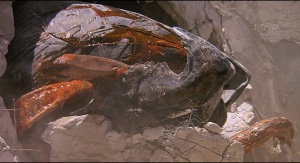 10. Tremors (Ron Underwood, 1990)
10. Tremors (Ron Underwood, 1990)
A sneakily underrated genre mishmash from the early ’90s, combining elements of horror, thriller, comedy and even Western cinema. Kevin Bacon and Fred Ward star as a couple of laconic handyman in a minuscule Nevadan town who discover the presence of an enormous worm creature (dubbed “Graboid” in the film) hiding just under the desert surface, and subsequently must engage in a gigantic game of hot lava in order to avoid being grabbed and eaten by the alien’s gaping mouth. Though the kind of ridiculous B-movie concept so popular in the ’50s, the script’s self-aware cleverness and devotion to its premise elevate the film several tiers above those cheesy monster flicks. It’s also got Reba McEntire as the female half of a fierce survivalist couple, so there’s that.
 09. Pitch Black (David Twohy, 2000)
09. Pitch Black (David Twohy, 2000)
The first installment in the now-three-films-strong Riddick franchise (not counting a direct-to-DVD animated flick and a couple of video games) is a strictly lo-fi affair, focusing on a small group of interstellar crash survivors (including Vin Diesel’s iconic antihero) stranded on a distant world with three suns. One twist, though: the planet is about to enter a rare total eclipse, during which nocturnal creatures (which look like a cross between Alien‘s xenomorph and Jaws‘ Great White Shark) will emerge from their hiding places to hunt and feed. Narratively simple but cinematographically bold, Twohy’s sci-fi horror was not intended to be a franchise starter (Riddick was originally supposed to die), and thus it’s a self-contained work, singular and effective.
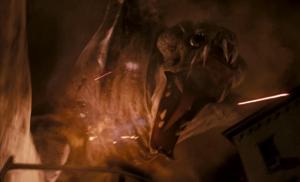 08. Cloverfield (Matt Reeves, 2008)
08. Cloverfield (Matt Reeves, 2008)
Everyone remembers the tantalizing teaser when it played in front of the first Transformers movie: a point-of-view party scene which turns into a disaster movie with the arrival of the Statue of Liberty’s decapitated head. But the film itself is more than just its concept: though ostensibly the first found-footage monster movie, it’s actually quite a deft look at terrorism and disaster in the post-9/11 age, recalling that fateful day in September through its NYC setting and obliteration of famous landmarks. Although the handheld camerawork (and nominal cameraman Hud) grow more nauseous and irritating as the film progresses, the final reveal of the monster itself – an enormous, multi-limbed, alien-looking beast – makes all those annoyances worth it.
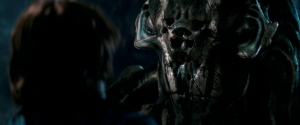 07. Super 8 (J.J. Abrams, 2011)
07. Super 8 (J.J. Abrams, 2011)
Not simply content to only produce the prior film, Abrams took the directorial reins for this Spielberg-influenced monster movie, his first venture following the massive success of Star Trek. Though obviously drawing much from Cloverfield – right down to its enigmatic teaser trailer and the design of the monster – it separates itself by focusing on a group of pre-teens making a Super 8 movie while mysterious events in their small Ohio town unfold. Set in 1979, its nostalgic tone and spotlight on precocious children is purely Spielbergian (the famed director co-produced), but Abrams puts his personal stamp on things with his now trademark lens flares and clean compositions. Adult actors Kyle Chandler and Noah Emmerich are reliably solid, but it’s really the child actors – specifically Dakota Fanning’s sister Elle – who impress, giving the film an authentic, down-to-earth feel.
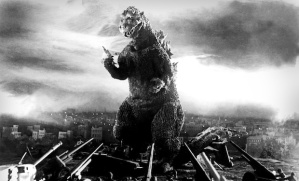 06. Gojira [Godzilla] (Ishirô Honda, 1954)
06. Gojira [Godzilla] (Ishirô Honda, 1954)
The King of the Monsters was first introduced in the granddaddy of all Japanese kaiju films, a stark drama that feels much unlike the cheesy creature clashes it inspired. Director Honda was a veteran of World War II, and the shadows of Hiroshima and Nagasaki loom heavily over the film – Godzilla’s radioactive nature and atomic breath would’ve surely been doubly horrifying for survivors of the two nuclear blasts. Even though the monster’s rubber-suited look and the model buildings he destroys haven’t aged well over the last 60 years, the film still remains brutally effective after all this time, with its focus on character and emotion above spectacle and farce remaining good lessons for burgeoning filmmakers. Let’s just hope the new one learned it.
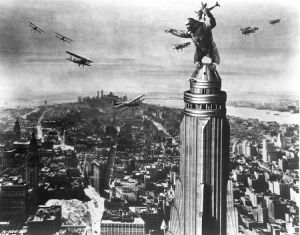 05. King Kong (Merian C. Cooper + Ernest B. Schoedsack, 1933)
05. King Kong (Merian C. Cooper + Ernest B. Schoedsack, 1933)
Twenty years before Godzilla first roared, adventurer directors Cooper and Schoedsack created the first giant cinematic monster: a huge ape hidden away on a remote tropical island in the South Pacific. As much an ethnographic documentary as a conventional monster movie, the film’s orientalization of the island’s primitive natives and even Kong himself is no doubt troubling, but the depiction of this exotic world where dinosaurs and other amazing animals have survived is surreal and stunning. And then there’s that final act, in which the ape rampages around Manhattan searching for his beloved Ann Darrow (Fay Wray) before climbing to the top of the then-newly-built Empire State Building and tragically falling to his death – simply iconic. It’s been remade twice, in 1976 by John Guillermin and 2005 by Peter Jackson; the original is still the best.
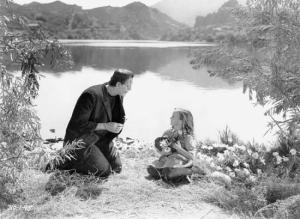 04. Frankenstein (James Whale, 1931)
04. Frankenstein (James Whale, 1931)
Though not a monster on the same size order as the others on this list, Dr. Frankenstein’s tragic creation deserves a spot if only for its quintessential reputation – who can think of movie monsters and not immediately picture Boris Karloff’s square-headed, neck-bolted freak of nature? Adapted from Mary Shelley’s canonical text but diverging significantly from it, Whale’s iconic horror work is one of the very best of its era (only his The Invisible Man can compete), exemplary from its dark and stormy night of conception to its fire-and-pitchforks finale. But it’s the meat in-between, in which Karloff’s misunderstood beast tries (and fails) to fit into normal society, that’s the most substantive and heart-breaking part. More faithful adaptations have followed, but this one remains a classic.
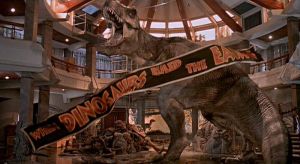 03. Jurassic Park (Steven Spielberg, 1993)
03. Jurassic Park (Steven Spielberg, 1993)
Who else but Spielberg could adapt Michael Crichton’s best-seller and bring dinosaurs back to life on the big-screen? A triumph of imagination and storytelling, just as unflinchingly effective now as it was twenty years ago – when I first surreptitiously watched it hiding behind the couch, deathly afraid of the Dilophosaurus’ colourful neck frill and toxic spitting venom. Each and every moment is a classic, from the first reveal of the gargantuan Brontosauruses to the T-Rex’s terrifying attack to the Velociraptors’ kitchen stalking, and it’s threaded throughout with an important warning against scientific recklessness and disrespect of nature. As Jeff Goldblum’s offbeat chaotician Ian Malcolm states, “life… finds a way”.
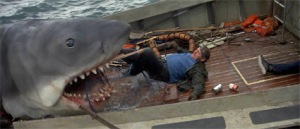 02. Jaws (Steven Spielberg, 1975)
02. Jaws (Steven Spielberg, 1975)
It’s fitting, perhaps, that these two Spielberg works appear back-to-back, as they represent two different watersheds in his career: his first blockbuster and his biggest commercial success. But it’s in this prototypical thriller (with healthy doses of adventure and horror for good measure) where the director’s name first became known across the world – the man responsible for scaring a generation of viewers out of the water. In its tale of three very different men – police chief Brody (Roy Scheider), oceanographer Hooper (Richard Dreyfus), and shark hunter Quint (Robert Shaw) – tracking a mammoth Great White, the film externalizes and literalizes the ubiquitous theme of man vs. nature, presenting its obscure monster as the ultimate symbol of environmental wrath. Three sequels followed; none are worth watching.
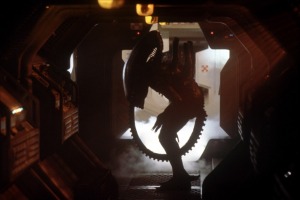 01. Alien (Ridley Scott, 1979)
01. Alien (Ridley Scott, 1979)
Ridley Scott’s first masterpiece is a perversely apt choice for top spot on this list; after all, xenomorph designer H.R. Giger died only yesterday. But his most famous creation will live on forever: a phallic, shiny, nightmarish extra-terrestrial conceived via a parasitic face-hugger and the most horrific birth scene imaginable. It’s easy to forget, in the wake of how many follow-ups and spin-offs, that the alien actually appears very little in the first film; akin to the shark of Jaws, it’s mostly suggested and implied, making it all the scarier. As it picks off the crew of the Nostromo one by one, however, it becomes more and more visible, finally emerging fully grown in the movie’s terrifying climax. When Ripley (Sigourney Weaver) finally jettisons the demonic beast into the void, she sits down to relax and bask in her victory, unaware of a far more insidious creature to come: the franchise sequel.
